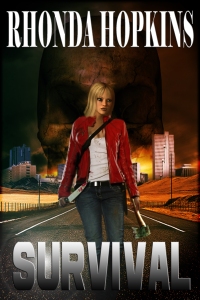Guest Post: Rhonda Hopkins #WinterofZombie
SURVIVAL: BUG OUT BAG
Planning for a zombie apocalypse? Or just an ordinary (is there such a thing?) emergency? Everyone has their own idea of what should go in a bug out bag (BOB). But here are a few of the things I think are important and you may want to consider getting together for TEOTWAWKI (The End of the World As We Know It). There are some items listed here that my characters have needed in my SURVIVAL series and not always had. So be prepared!
First of all you’ll need something to put everything in. Make sure you have a durable backpack. You’ll want to be able to keep your hands free in case you need to do some zombie killing. The backpack should be well made so that it doesn’t split a seam and spill out all your carefully assembled items. If you’re on the run, you won’t have time to stop and collect it all. Check military surplus and outdoor stores for good options. One that has webbing that allows you to clip on other items to the outside of the pack would be great.
What you pack and how much depends on you. How much weight can you comfortably carry? You might have to walk for miles with that pack on your back. So make sure you don’t overload it. It’s better to have a few necessary items than to have to leave all of it behind because you can’t carry it and don’t have time to stop and sort through it.
Probably the most important thing besides your brain power is water. You can fit a few emergency water pouches in your bag, but put some purification tablets in there as well. That way you can purify any water you come across. You really don’t want to have the runs while you’re on the run, so some form of purification is necessary. Here are someinstructions from the U.S. Environmental Protection Agency for purifying water in an emergency. It might be a good idea to print that page out and put it in your pack. You’ll need a water bottle or canteen as well. There are some water filtration bottles out there that you can use for drinking, but they can get pricey and you’ll still need to pack replacement cartridges.
Put any papers or things that may ruin if wet in plastic baggies.
A first aid kit will probably come in handy. Make sure it has bandages, alcohol swabs, gauze, tape, aspirin (Advil or Tylenol), elastic bandage, antibiotic ointment, tweezers, and scissors. You might need calamine lotion or other anti-itch cream in case you get into something rash-inducing. And an instant chemical cold pack might prove useful for sprains or other injuries.
Consider adding a sewing kit. And of course duct tape is a must. You never know when you may have to “MacGyver” your way to a solution. You can even make an emergency stretcher out of duct tape.
You’ll need a flashlight and extra batteries. A good hand-crank flashlight will alleviate the need for the batteries. A headlamp would keep your hands free.
Protein and meal replacement bars are a good option. You can also put in a few freeze-dried emergency meal packages, oatmeal packets, and trail mix snacks. Most experts recommend 1500 to 3000 calories per day per person with a three day supply minimum. Check for guides on edible plants in your area as well as guides on trapping small game. It might prove worth your time to read some articles online and watch some videos in advance. Pack a fishing line as well. Even if you’re not near a place to catch fish, it might come in handy in other situations. You’ll also need a plate/bowl and eating utensils. You can find cooking sets that come with bowls/cups and utensils that all nest into one neat package.
You’ll also need something to light a fire with – matches, lighters, or other types of fire starters. Put the matches in a water proof container. Vaseline soaked cotton balls are a quick way to get a fire going.
Don’t forget shelter. It’s possible you might be sleeping outdoors. If you live in an area where you can get by on a lightweight option, that’s great. But you might live in a climate where a four season tent would be your best alternative. Do you need a one person tent or one for a family?
A sleeping bag suitable for your climate is also a good idea. If you use a compression sack, this will shrink the size of the bag and take up less space. Solar blankets are good to have in your pack as well.
Consider adding a rain tablet – a small notebook you can write on when wet – and pen or pencil.
A knife and a multi-purpose tool, a small folding shovel, & paracord rope are good additions, as are sunscreen, bug spray, and lip balm (a jar of Carmex is a good option).
Add some zip lock bags. (All bags are not created equal. Test them out. Make sure they won’t leak.)
A map of the area might be needed if you can’t get a signal for your GPS.
Small Address/Phone book for those you may need to contact in an emergency.
A weapon to keep you and your family safe. Make sure it’s something you’re comfortable using; otherwise, it could turn into a weapon used against you. Know how to set a trap or set up early warning signals to give you a chance to get away or prepare to fight.
A set of extra clothing and gloves that are flexible enough to carry out tasks. Pants with lots of pockets are a great option. Add a poncho for rainy days.
Gather together some personal toiletries:
- Travel size toothpaste, soaps, shampoos, etc.
- Dental floss and toothbrush
- Brush/comb
- Elastic band to pull hair back
- Toilet paper
- Hand sanitizer
- Wash cloth and/or wet wipes
- Feminine hygiene products
- Dish soap
If you know you can’t carry the weight of all this – choose the most important for your backpack. Then pack another bag to carry in your car. The second most needed items in one bag and then another for “would be nice to have” items. You may end up leaving all but the backpack behind, so pack carefully.
Other things to keep in mind:
Keep your cell phone charged at all times. Wouldn’t it just suck to need it in an emergency and you find it DOA? You can find some inexpensive solar chargers on Amazon. There are even ones that do double or triple duty as a flashlight or flashlight and hand-crank radio.
A hand-crank radio is a good way to stay in touch with what’s going on in the world.
Never let your gas tank get below the halfway mark. You never know when you might need to be able to leave in a hurry. You don’t want to be stuck in line at a gas station with everyone else. It’s very possible tempers will flare and there’s a good chance of getting hurt even before you get started. You can always get gas later. But it’s a good idea to have a gas can or two filled and ready to load in your car if needed.
When the SHTF, you also want to steer clear of pharmacies, grocery stores, and hospitals for the same reason. So plan ahead and make sure you have what you need in advance for emergency situations.
If you take prescription medications, make sure you keep those all in one place where they are easy to grab and go.
In case you are able to travel by car, it’s a good idea to have a few gallons or cases of water and extra food supplies and clothing to take with you ready to go.
Have a designated meeting place for family members and friends in case of an emergency. There is safety in numbers, so the more prepared individuals you have as a team, the better.
Check expiration dates every six months and replace items as necessary. If you’re really organized, keep a list of everything in your bag and put the expiration dates there. That way you don’t have to actually unpack your bag each time.
All that specialized equipment you’ve bought? Make sure you know how to use it. Practice with it. It won’t do you any good if you need it and have no idea how to operate it.
That’s it. So, what did I miss? Let me know in the comments what you think are essentials for your bug out bag.
Award-winning author, Rhonda Hopkins, has learned firsthand that truth is stranger than fiction. Her two decades of experience as an investigator provide her characters with a depth and realism that gives truth a run for its money. Having come in contact with the best and the worst that society has to offer, Rhonda’s imagination is filled with story ideas. Rhonda writes horror, suspense, paranormal, and YA urban fantasy. She is the author of thezombie apocalypse series, SURVIVAL, and the award-winning paranormal novella, THE CONSUMING. She also has a non-fiction book, NAVIGATING FAMILY COURT: IN THE BEST INTEREST OF YOUR CHILD, to assist those going through custody litigation.
You can connect with Rhonda at:
Website: http://rhondahopkins.com
Facebook: http://facebook.com/RhondaHopkins.Author
Twitter: http://twitter.com/Rhonda_Hopkins
Goodreads: http://www.goodreads.com/rhondahopkins
Pinterest: http://pinterest.com/rhondarhopkins
Find more from Rhonda at Amazon: http://www.amazon.com/Rhonda-Hopkins/e/B009KWDCCW
* * * * *
The stench of frozen flesh is in the air! Welcome to the Winter of Zombie Blog Tour 2015, with 40+ of the best zombie authors spreading the disease in the month of November.
Stop by the event page on Facebook so you don’t miss an interview, guest post or teaser…and pick up some great swag as well!
Giveaways galore from most of the authors as well as interaction with them!
#WinterofZombie is the hashtag for Twitter, too!

